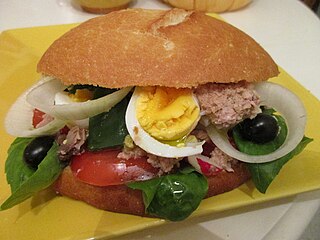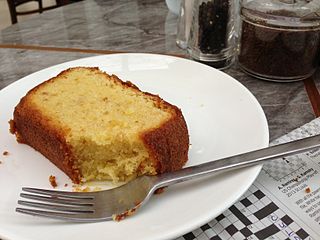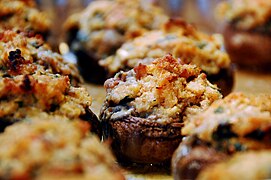
A sausage is a type of meat product usually made from ground meat—often pork, beef, or poultry—along with salt, spices and other flavourings. Other ingredients, such as grains or breadcrumbs, may be included as fillers or extenders.
An hors d'oeuvre, appetiser or starter is a small dish served before a meal in European cuisine. Some hors d'oeuvres are served cold, others hot. Hors d'oeuvres may be served at the dinner table as a part of the meal, or they may be served before seating, such as at a reception or cocktail party. Formerly, hors d'oeuvres were also served between courses.

Meatloaf is a dish of ground meat that has been combined with other ingredients and formed into the shape of a loaf, then baked or smoked. The final shape is either hand-formed on a baking tray, or pan-formed by cooking it in a loaf pan. It is usually made with ground beef, although ground lamb, pork, veal, venison, poultry, and seafood are also used, sometimes in combination. Vegetarian adaptations of meatloaf may use imitation meat or pulses.

Pierogi are filled dumplings made by wrapping unleavened dough around a filling and cooked in boiling water. They are occasionally flavored with a savory or sweet garnish. Typical fillings include potato, cheese, quark, sauerkraut, ground meat, mushrooms, fruits, and/or berries. Savory pierogi are often served with a topping of sour cream, fried onions, or both.

Moussaka is an eggplant (aubergine)- or potato-based dish, often including ground meat, which is common in the Balkans and the Middle East, with many local and regional variations.

A baked potato, known in some parts of the United Kingdom as a jacket potato, is a preparation of potato originating from Peru. It may be served with fillings, toppings or condiments such as butter, cheese, sour cream, gravy, baked beans and tuna.

Deviled eggs, also known as stuffed eggs, curried eggs or dressed eggs, are hard-boiled eggs that have been peeled, cut in half, with the yolk scooped out and then refilled having been mixed with other ingredients such as mayonnaise, mustard and sprinkled with paprika, cinnamon or curry powder. They are generally served cold as a side dish, appetizer or a main course during gatherings or parties. The dish's origin can be seen in recipes for boiled, seasoned eggs as far back as ancient Rome, where they were traditionally served as a first course. The dish is popular in Europe, North America and Australia.

Kofta is a family of meatball or meatloaf dishes found in South Asian, Central Asian, Balkan, Middle Eastern, North African, and South Caucasian cuisines. In the simplest form, koftas consist of balls of minced meat—usually beef, chicken, pork, lamb or mutton, or a mixture—mixed with spices and sometimes other ingredients. The earliest known recipes are found in early Arab cookbooks and call for ground lamb.

A vol-au-vent is a small hollow case of puff pastry. It was formerly also called a patty case.
Oysters en brochette is a classic dish in New Orleans Creole cuisine. Raw oysters are skewered, alternating with pieces of partially cooked bacon. The entire dish is then broiled or breaded then either deep fried or sautéed. The traditional presentation is on triangles of toast with the skewer removed and dusted with salt and pepper or topped with either Maitre d'Hotel butter or a Meunière sauce. When prepared well, the dish should have a crispy exterior and a soft savory center with a textural contrast between the bacon and the oyster. It was usually offered on restaurant menus as an appetizer; but was also a popular lunch entrée.

The pan bagnat is a sandwich that is a specialty of Nice, France. The sandwich is composed of pain de campagne, a whole wheat bread, enclosing a salade niçoise, a salad composed mainly of raw vegetables, hard boiled eggs, anchovies and/or tuna, and olive oil, salt, and pepper. Sometimes vinegar is added, but never mayonnaise. It was historically prepared to use day-old bread.

Angels on horseback is a hot hors d'œuvre or savoury made of oysters wrapped with bacon. The dish, when served atop breads, can also be a canapé.

Queso flameado, also known as queso fundido or choriqueso, is a dish of hot melted cheese and spicy chorizo that is often served flambé. Often compared to cheese fondue, it is a party dish; it is popular at cookouts and in restaurants as an appetizer. Almost unique in Mexican cuisine, in the cuisine of the United States this dish has been widely adapted and is considered a native dish in El Paso. In Mexico, it occurs in restaurants more often in the north. Typical main ingredients are melted cheese and a characteristic meat sauce of loose fresh chorizo, tomato, onion, chile and spices. It is served in a small, shallow casserole or other ceramic or metal heat-proof baking dish. The cheese and sauce are prepared separately, and combined just before serving. This may be done at the table, especially if finished with a flambé: high alcohol liquor is poured on the cheese and ignited, and as it burns the server folds in the sauce. If not flambéed, the mixture may be quickly broiled. Either way, the finished dish is presented while it is still bubbling hot, and it is spooned onto small soft tortillas for individual servings.

This is a categorically organized list of foods. Food is any substance consumed to provide nutritional support for the body. It is produced either by plants, animals, or fungi, and contains essential nutrients, such as carbohydrates, fats, proteins, vitamins, and minerals. The substance is ingested by an organism and assimilated by the organism's cells in an effort to produce energy, maintain life, or stimulate growth.

Crab dip, sometimes referred to as Maryland crab dip, is a thick, creamy dip that is typically prepared from cream cheese and lump crab meat. Other primary ingredients such as mayonnaise may be used. Various types of crab preparations, species and superfamilies are used, as are a variety of added ingredients. It is typically served hot, although cold versions also exist. Hot versions are typically baked or broiled. It is sometimes served as an appetizer. Accompaniments may include crackers and various breads. Some U.S. restaurants offer crab dip, commercially produced varieties exist, and some stadiums offer it as a part of their concessions.

The Eurasian cuisine of Singapore and Malaysia is a type of fusion cuisine.

Sautéed mushrooms is a dish prepared by sautéing edible mushrooms. It is served as a side dish, used as an ingredient in dishes such as coq au vin, beef bourguignon, and foods such as duxelles, as a topping for steaks and toast, and also as a garnish.

Bacon-wrapped foods are foods that are prepared by being covered in bacon. They may be baked, fried, or grilled. Popular bacon-wrapped dishes include angels on horseback, devils on horseback, and pigs in blankets. Bacon has long been used for barding roasts, especially game birds.






















